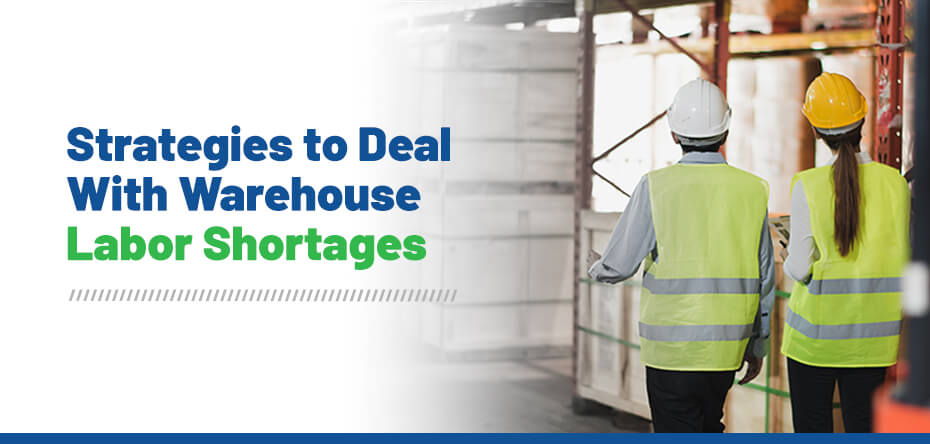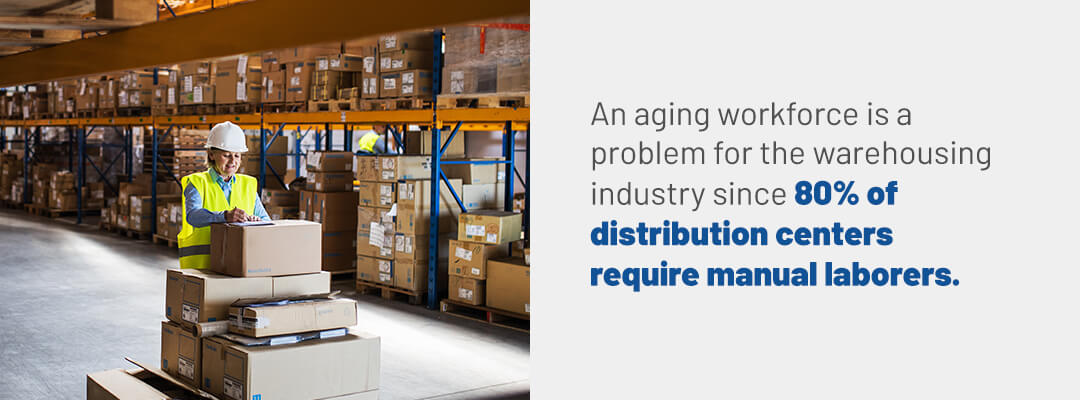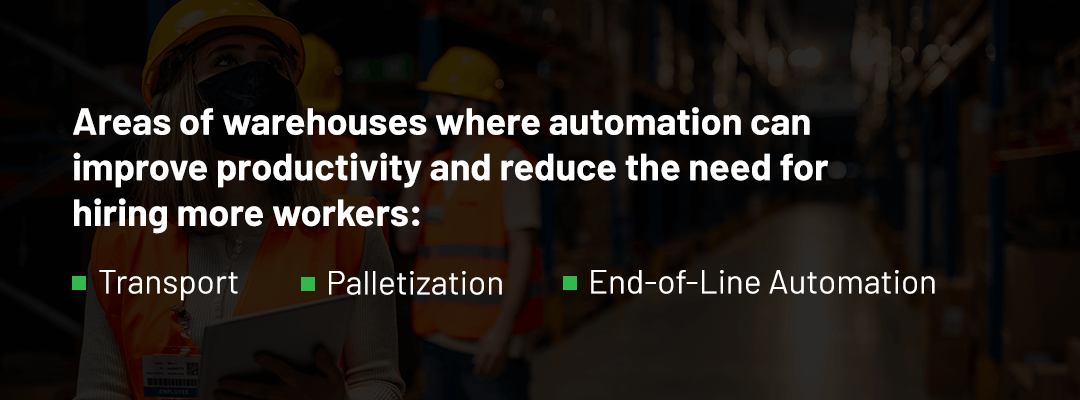Strategies to Deal With Warehouse Labor Shortages
Warehouse labor challenges stem from the combination of multiple problems that have long been plaguing the industry. E-commerce sales have boomed in recent years. Demand for warehouse space increased by 22% year-over-year (YoY) in 2021 per Jones Lang LaSalle. Additionally, as of January 2022, fulfillment volume increased for more than half of facilities, according to Instawork’s The State of Warehouse Labor Survey. These issues resulted in 60% of distribution centers, warehouses, and 3PLs struggling to keep up.
The labor shortage has made warehouse work difficult, especially amid the increasing demand for warehouse workers. Companies that want to thrive in the future should examine their operations and see how to reduce the impact of worker shortages on their operations.
Trends Behind the Warehouse Worker Shortage
Increasing demand for warehouse workers meets an existing shortage of labor that has worsened over time. High turnover rates, an aging workforce, and a high industry demand for manual labor combine to worsen the labor problems facing warehouses.
High Turnover Rates
High demand for warehousing services means workers face long hours and extra stress to meet the fulfillment needs. The intense strain on the body and stress of working in a warehouse contribute to high turnover rates. Turnover rates have only increased in recent years.
In 2017, turnover in the transportation, utilities, and warehousing sector was 40.9% and increased slowly through 2019 before spiking to almost 60% in 2020. That number only dropped to 49% in 2021, which still followed the trend that started before 2020.
An Aging and Retiring Population
Higher turnover is only one facet of the issue. Another is the aging and retiring population. The consequences of an aging workforce have become more evident as industry analysts watch the Baby Boomer generation come closer to retirement. However, with more people retiring and a younger population that does not have the numbers to take their place, the pool of available laborers is shrinking.
The population is on track to have more people over the retirement age of 65 than those under 18 by 2034. This creates a problem for the warehousing industry — many workers retire, and fewer young people will be available to take their places. However, many Baby Boomers may opt to leave physical labor for less intensive work that puts less strain on their aging bodies even before they reach retirement age. Therefore, the problem of the aging population will hit the warehouse industry long before those in this group retire.
Heavy Reliance on Manual Labor
An aging workforce is a problem for the warehousing industry since 80% of distribution centers require manual laborers. Without enough people to replace those retiring or leaving, facilities must find alternative ways to get their increasing amounts of work done.
Finding ways to keep workers within the industry and reduce reliance on manual labor will reduce the impact of the labor shortage on warehouses and distribution centers.
Retention Strategies for Warehouse Laborers
Keeping workers on staff can reduce the problems caused by competing for workers in a shrinking labor pool. Warehouses can raise worker satisfaction and increase employee retention using several methods. These methods include the following:
Increasing Pay
In many sectors, money talks. Employers recently found success keeping warehouse workers by offering higher wages or bonuses. By raising pay, facilities also remain competitive among other warehouses that might hire away workers.
Among those surveyed for the Instawork State of the Warehouse study, 36% offered hourly wage increases to their workers between $1 and $1.99. Another 50% raised wages by more than $2 an hour, resulting in an industry-wide average pay increase of $2.54 per hour.
The downside to raising pay is the upper limit where pay increases no longer become profitable. Therefore, combining higher wages with other incentives provides a more effective long-term way of retaining workers.
Offer Flexible Scheduling
Among the top requests from workers in warehouses is better, more flexible scheduling. Unfortunately, the Instawork study noted that less than half of businesses in this sector invest their resources into providing workers with greater flexibility. Instead of choosing warehouse jobs, many potential workers may opt for the flexibility of the gig economy. Warehouse managers need to compete with these businesses.
Warehouses that meet the worker’s need for flexible hours will have a competitive edge in retaining and hiring employees. They can tap into new groups of potential workers such as students, stay-at-home parents of school-age kids, and retirees who may need work in shorter time blocks. Introducing 20-hour jobs with flexible hours throughout the week may draw these groups of workers into the field.
Incentivize Performance
Showing workers appreciation for stellar performance encourages others to stay on the job and work well. When creating incentive programs such as bonuses, always create balance with the achievements. Allow anyone in the warehouse to receive an incentive through extra work instead of their daily tasks.
Incentives could reward workers or teams for improved safety or reduced errors. Cash is only one reward option. Other options include extra paid vacation days or time off, priority picking for shifts or jobs, free lunches, or preferred parking spots. Getting employee input on what they want for rewards and goals will also improve participation in incentive programs — the workers will feel more valued.
Create a Worker-Friendly Environment
Make the work environment as worker-friendly as possible. Enhanced safety will keep workers protected from acute injuries and accidents. Automating some physically intensive processes and offering ergonomically correct equipment can also prevent more subtle long-term stress injuries.
Cleaner, more organized warehouses reduce stress on workers. Clean workplaces make the environment safer to operate in and decrease the number of steps employees need to take to get products or equipment they need. When workers take fewer steps during their shifts, they feel less fatigued at the end of the day, reducing their chances of burnout.
Invest in Worker Development and Engagement
Don’t let existing workers feel left out as technology improves in warehouses. Train them in operating new machinery, and allow them to build skills and value for their current and future jobs. Training will also reduce the need to hire more educated workers to operate advanced equipment as the facility upgrades its machinery.
Hiring and Recruitment Strategies for Warehouse Workers
The increased demand from warehouses will likely require most facilities to find ways to hire new workers even if they retain current employees. Several outside-the-box methods of recruiting new workers could alleviate staffing shortages caused by higher demand.
Staffing Agencies
Local and national staffing agencies can help fill the labor gaps in warehouses. In the Instawork survey, 67% reported using local staffing agencies, and 22% chose national agencies. Unfortunately, 84% of respondents used at least two staffing providers, but only 6% got the workers they needed. Staffing agencies can work for filling a few roles, but they should not be the only source of hiring new workers.
Temporary Labor
Temporary labor helps reduce workloads during seasonal high operation times. These workers can also provide a stop-gap to fulfill immediate labor needs until a facility can source more long-term employees. Additionally, hiring workers as temporary labor allows those who might otherwise choose the gig economy to pick a warehouse job for a few months.
Employee Referral Programs
Workers can refer others they know to a warehouse position. Offering incentives for employee referrals that result in hires benefits both workers — who become active in finding referrals — and the warehouse, which increases its staff.
Adjust Advertising in Employment Ads
Lastly, adjusting the presentation of a job in ads can improve interest in the position and increase hiring. Effective job ads are optimistic about employees, work requirements, and workplace conditions with hints of a fun, fast-paced environment. However, these are only some attributes to include in employment ads.
Perks provided for workers should also appear in the employment ads. Warehouses that offer upskill training, safe environments, flexible scheduling, and incentive programs should always mention these when trying to attract applicants.
Whether promoting temporary positions or full-time work, note the potential for building a career in the warehousing industry. Emphasizing the importance of the work regarding maintaining the supply chain and ensuring the growth of companies worldwide also excites potential applicants by showing their value from the start.
Following through on promises made in employment ads is essential. Companies that promote the value of warehouse workers in ads must continue to value their workers through benefits, requesting employee input on policies, and incentivizing performance. If promises of flexible scheduling appear in an ad, always make it available to new and existing workers. Failure to meet the expectations created in employment ads will result in the rapid turnover of new hires.
Can Warehouse Automation Help Solve the Labor Shortage?
In the face of a smaller labor pool, automation can reduce the need for more workers while making existing work less straining on current employees. Choosing where to integrate partial or fully automated machinery starts with assessing operations. Consider areas of warehouse operations that have the greatest need for optimizing productivity or reducing the need for manual labor. These may include congested areas without space for multiple workers, tasks that could take less time through automation, or jobs that require unskilled manual labor.
Investing in workers to operate the new automation equipment will pay off when you don’t need to hire a new group of skilled workers. Monitoring productivity, order accuracy, and speed will show improvements in these areas and the point when the investment in new machinery becomes profitable.
The following are some areas of warehouses where automation can improve productivity and reduce the need for hiring more workers:
Transport
Much of the picking time in warehouses consists of workers traveling to the location to pull orders from shelves. Automating the delivery processes from picking sites to shipping areas helps orders come off the shelves faster, and workers don’t spend extra time making wasted steps.
Several options for transport can alleviate the wasted time from workers manually picking and delivering each order. The simplest method that does not require much room is a fleet of automated guided vehicles (AGVs). These vehicles follow a programmed route and sensors installed in the warehouse to pick up products from areas within the storage space and deliver them to the shipping zone.
A more high-tech alternative to AGVs is autonomous mobile robots (AMRs), which have onboard software maps of the facility for more intelligent navigation. These systems, too, can deliver products to the shipping area while avoiding obstacles on the way.
Conveyers provide larger footprint solutions for taking goods down to shipping from the storage area. These replace walkways with raised moving belts to allow for automated transfer of goods.
Palletization
Robotic solutions can automate palletization and depalletization to speed the rate of stocking and shipping orders. These systems use computer scanning or vision programs to handle loading or unloading pallets of one or multiple stock-keeping units (SKUs). This flexibility reduces the need for manual labor to do these tasks, helping reduce strain on workers.
End-of-Line Automation
End-of-line automation includes pallet wrapping or securing with strapping equipment. These tasks typically require unskilled labor. With automation, employees could work in other parts of the warehouse. By fully or partially automating these tasks, the resulting shipments have fewer errors and better execution at faster rates compared to manually strapped or wrapped products. For example, several fully automatic strapping systems can handle dozens of units per minute or more. These systems dramatically cut the time required for sealing and strapping containers to prepare them for shipping.
Why Start With Automating End-of-Line Warehousing Processes?
The first place to integrate automation into a warehouse should be in the end-of-line processes. Machinery for end-of-line processes accounts for 47% of packaging machinery, with increases likely into 2026. The higher need for end-of-line process machinery comes from several needs, including reducing reliance on labor, providing more supply chain visibility, handling more SKUs, and making operations more sustainable.
By choosing automated packaging machines that offer greater reliability than manual work, warehouses can reduce waste and rework, making their operations more sustainable and faster. Even operator-cycled strapping equipment reduces the number of workers needed for strapping processes and eases the burden of finding workers for this area of the warehouse.
End-of-line automation is a simple way to mitigate labor shortages and improve productivity without making significant changes to the overall operations within the facility.
EAM-Mosca Corporation Strapping Products Support Your Warehouse Operations
EAM-Mosca Corporation specializes in manual and automatic strapping products. Our automatic strapping systems are reliable and reduce the need for rework while optimizing line speed. You can reduce your reliance on extra labor by automating the end-of-line warehousing process with our strapping equipment. Let us help you to thrive in a tight warehouse labor market. Shop our selection of strapping machines to find out about our operator-cycled or fully automatic strapping systems and keep pace with the increasing demand from your warehouse.






